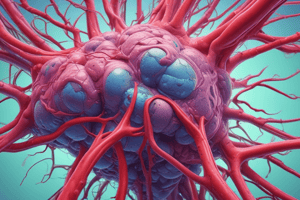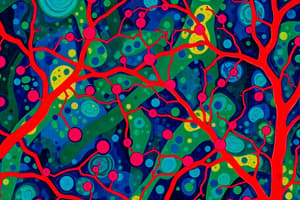Podcast
Questions and Answers
What primarily regulates the net movement of fluid across the capillary wall?
What primarily regulates the net movement of fluid across the capillary wall?
- Temperature and pressure differences
- Hydrostatic and osmotic pressures (correct)
- Electrolyte concentrations in the blood
- Blood cell density and speed
Which statement correctly describes the structure of capillaries?
Which statement correctly describes the structure of capillaries?
- They consist of multiple layers of endothelial cells.
- Capillaries possess a single layer of endothelial cells. (correct)
- Capillaries are the largest blood vessels in the body.
- They are approximately 1 mm in diameter.
What mechanism allows lipid-soluble substances to exchange across capillary membranes?
What mechanism allows lipid-soluble substances to exchange across capillary membranes?
- Active transport
- Endocytosis
- Facilitated diffusion
- Diffusion (correct)
In which condition are all metarterioles typically opened?
In which condition are all metarterioles typically opened?
Which factor affects the density of capillaries in a given tissue?
Which factor affects the density of capillaries in a given tissue?
What is the primary function of fenestrated capillaries in tissues such as the intestine and kidneys?
What is the primary function of fenestrated capillaries in tissues such as the intestine and kidneys?
Which pressure is primarily responsible for the movement of fluid into the capillaries?
Which pressure is primarily responsible for the movement of fluid into the capillaries?
What happens when hydrostatic pressure becomes less than osmotic pressure in a capillary?
What happens when hydrostatic pressure becomes less than osmotic pressure in a capillary?
What role do pressure gradients play in the process of bulk flow across capillary walls?
What role do pressure gradients play in the process of bulk flow across capillary walls?
What occurs in the first portion of a capillary where hydrostatic pressure exceeds osmotic pressure?
What occurs in the first portion of a capillary where hydrostatic pressure exceeds osmotic pressure?
What happens to interstitial fluid when the lymphatic system cannot keep up?
What happens to interstitial fluid when the lymphatic system cannot keep up?
What role does hydrostatic pressure play during blood loss?
What role does hydrostatic pressure play during blood loss?
Which mechanism does NOT contribute to edema formation?
Which mechanism does NOT contribute to edema formation?
What can cause an increase in interstitial fluid accumulation due to decreased osmotic pressure?
What can cause an increase in interstitial fluid accumulation due to decreased osmotic pressure?
In the clinical example of an 8-year-old horse, what is primarily causing the dependent edema?
In the clinical example of an 8-year-old horse, what is primarily causing the dependent edema?
What happens when the lymphatic system cannot keep up with fluid accumulation?
What happens when the lymphatic system cannot keep up with fluid accumulation?
Which mechanism is NOT responsible for edema formation?
Which mechanism is NOT responsible for edema formation?
How does increased arterial pressure contribute to edema formation?
How does increased arterial pressure contribute to edema formation?
Which condition could result in increased interstitial fluid due to low protein concentrations in plasma?
Which condition could result in increased interstitial fluid due to low protein concentrations in plasma?
What is the physiological significance of bulk flow in terms of stabilization of blood volume?
What is the physiological significance of bulk flow in terms of stabilization of blood volume?
What initiates the process of filtration across the capillary walls?
What initiates the process of filtration across the capillary walls?
Which of the following is a characteristic of fenestrated capillaries?
Which of the following is a characteristic of fenestrated capillaries?
What is the primary function of capillaries in the circulatory system?
What is the primary function of capillaries in the circulatory system?
How does the net movement of fluid across capillary walls change along the length of a capillary?
How does the net movement of fluid across capillary walls change along the length of a capillary?
What determines the rate of transcapillary exchange?
What determines the rate of transcapillary exchange?
How do metarterioles contribute to blood flow regulation?
How do metarterioles contribute to blood flow regulation?
What effect does vasodilation of arterioles have on hydrostatic pressure in capillaries?
What effect does vasodilation of arterioles have on hydrostatic pressure in capillaries?
What happens to fluid movement when hydrostatic pressure decreases below osmotic pressure in capillaries?
What happens to fluid movement when hydrostatic pressure decreases below osmotic pressure in capillaries?
What characteristic of capillaries contributes to the slow flow of blood?
What characteristic of capillaries contributes to the slow flow of blood?
What type of substances can generally cross capillary membranes freely?
What type of substances can generally cross capillary membranes freely?
Flashcards are hidden until you start studying
Study Notes
Microcirculation Role
- The smallest blood vessels, capillaries, are responsible for the exchange of substances between blood and tissues.
- Capillaries represent only 5% of the total blood volume.
- They are the sites where water, nutrients, waste products, and gases are exchanged with interstitial fluid and tissues.
- Capillaries have a diameter of 7-8 micrometers, allowing red blood cells (7.5 micrometers diameter) to pass through.
- The walls of capillaries are composed of a single layer of endothelial cells, facilitating efficient exchange.
- Capillaries form dense networks, ensuring all cells within 100 micrometers are close to a capillary.
Capillary Network
- The density of capillaries varies depending on the metabolic activity of the tissue.
- Metarterioles, connecting arterioles to capillary networks, possess smooth muscle rings that regulate blood flow.
- In skeletal muscle, all metarterioles open during exercise, maximizing blood supply.
- The small diameter of capillaries results in slow blood flow, facilitating adequate time for exchanges.
- The extensive branching of capillaries reduces resistance to blood flow.
Transcapillary Exchange Mechanisms
- Diffusion: Movement of substances across capillary walls from areas of high concentration to lower concentration.
- Lipid-soluble substances (oxygen and carbon dioxide) readily diffuse across cell membranes.
- Water and lipid-insoluble molecules (sodium, chloride, glucose, and amino acids) move through pores or clefts in capillary walls.
- The size and number of pores vary depending on the tissue.
- Some capillaries are fenestrated (intestine, liver, kidneys), containing large gaps that allow water and soluble macromolecules to pass.
- Bulk Flow: Mass movement of fluid and dissolved substances driven by pressure gradients.
- Filtration: Movement out of capillaries into interstitial fluid.
- Absorption: Movement from interstitial fluid back into capillaries.
- Bulk flow maintains fluid balance between intravascular and interstitial compartments.
- Factors influencing bulk flow:
- Pressure gradients (hydrostatic and osmotic)
- Permeability of capillary walls
- Size of the diffusion surface
- Blood flow
Pressure Gradients & Starling Forces
- Hydrostatic pressure: Pressure generated by the heart that drives filtration out of capillaries.
- The pressure in the interstitial fluid is negligible.
- Colloid osmotic pressure (oncotic pressure): Pressure generated by the presence of large proteins, primarily albumin, within blood vessels.
- This pressure opposes hydrostatic pressure due to the tendency of water to move towards areas of higher solute concentration.
- Starling forces represent the balanced forces driving filtration and absorption across capillary walls.
- Hydrostatic pressure pushes fluid out of capillaries.
- Osmotic pressure draws fluid into capillaries.
- In the first portion of the capillary, hydrostatic pressure dominates leading to filtration.
- Towards the end, hydrostatic pressure decreases, and if it becomes lower than osmotic pressure, net reabsorption occurs.
Fluid Movement & Lymphatic System
- The majority of fluid that enters the interstitial space during filtration is collected by the lymphatic system.
- The lymphatic system drains this fluid back into large veins.
- Fluids that remain in the blood after filtration return to the heart via venules.
- When the lymphatic system cannot handle the excess fluid, edema develops.
Edema Formation: Causes & Mechanisms
- Edema is the abnormal accumulation of fluid within the interstitial space.
- Four main mechanisms contribute to edema formation:
- Increased hydrostatic pressure:
- Hypertension (high blood pressure)
- Increased venous pressure (heart failure, venous obstruction)
- Increased interstitial protein concentration:
- Inflammation of capillaries, causing increased leakiness.
- Decreased oncotic pressure:
- Loss of plasma proteins (GI disease, liver disease, malnutrition)
- Obstruction of lymphatic vessels:
- Lymphatic dysfunction or blockage preventing proper fluid drainage
- Increased hydrostatic pressure:
Edema Example
- "Dependent edema" refers to swelling in areas located below the heart, such as the legs.
- Dependent edema can be caused by right-sided heart failure, leading to increased venous pressure and subsequent filtration pressure in the affected areas.
Microcirculation and Fluid Exchange
- The microcirculation is responsible for the exchange of water, nutrients, waste products, and gases between the blood and the interstitial fluid.
- Capillaries are the smallest blood vessels, with a single layer of endothelial cells and a diameter of 7-8 µm.
- Red blood cells are about 7.5 µm in diameter, meaning they must travel through capillaries in a single file line.
- The density of capillaries within a tissue varies, depending on the metabolic activity of the tissue.
- Metarterioles are small arterioles that directly connect to the capillary network.
- Most capillaries contain pores or clefts that allow the passage of water and small, lipid-insoluble molecules.
- Some capillaries, such as those in the intestines, liver, and kidneys, are fenestrated and contain large gaps allowing for the passage of large molecules.
Transcapillary Exchange
- Transcapillary exchange involves both diffusion and bulk flow.
- Diffusion is the movement of substances across the capillary wall, driven by concentration gradients.
- Lipid-soluble substances, such as oxygen and carbon dioxide, can diffuse freely across capillary membranes.
- Water and lipid-insoluble molecules, such as sodium, chloride, glucose, and amino acids, move through pores or clefts.
- Bulk flow is the mass movement of water and dissolved substances across the capillary wall, driven by pressure gradients.
- Two types of pressure gradients influence bulk flow: hydrostatic pressure and osmotic pressure.
Hydrostatic Pressure
- Hydrostatic pressure is the pressure exerted by a fluid against a surface.
- In the microcirculation, hydrostatic pressure pushes fluid out of the capillaries and into the interstitial space.
Osmotic Pressure
- Oncotic pressure is also known as colloid osmotic pressure.
- Oncotic pressure is caused by proteins, which remain in the blood and attract water.
- This pressure counteracts the hydrostatic pressure, pulling fluid back into the capillaries.
Starling Forces
- The balance between hydrostatic and osmotic pressures determines the net movement of fluid across the capillary wall.
- The net movement of fluid is generally towards the interstitial space, where it is picked up by the lymphatic system before being returned to the blood via large veins.
- If the lymphatic system is unable to keep up with the accumulation of fluid, edema forms.
Edema Formation
- Edema is the abnormal accumulation of fluid in the interstitial space.
- There are four main mechanisms that can cause edema:
- Increased hydrostatic pressure, such as that caused by hypertension or right-sided heart failure.
- Increased interstitial protein concentration, due to inflammation or a "leaky" capillary wall.
- Decreased oncotic pressure, due to protein loss or poor nutrition.
- Obstruction of lymphatic vessels.
Clinical Example
- Dependent edema is swelling in the lower extremities and other areas of the body that are normally below the heart.
- This is often a sign of right-sided heart failure because the right side of the heart is unable to pump blood effectively, leading to venous congestion.
- Venous congestion increases hydrostatic pressure, resulting in increased fluid filtration into the interstitial space.
Studying That Suits You
Use AI to generate personalized quizzes and flashcards to suit your learning preferences.




